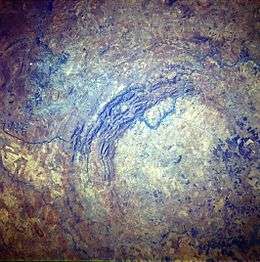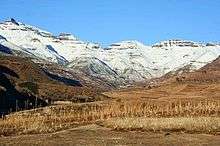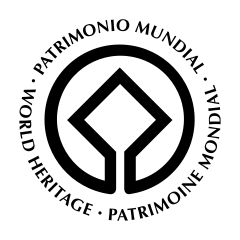List of World Heritage Sites in South Africa
The United Nations Educational, Scientific and Cultural Organization (UNESCO) World Heritage Sites are places of importance to cultural or natural heritage as described in the UNESCO World Heritage Convention, established in 1972.[1] South Africa accepted the convention on 10 July 1997, making its historical sites eligible for inclusion on the list. As of 2018, there are nine World Heritage Sites in South Africa, including four cultural sites, four natural sites and one mixed site.[2]

World Heritage Sites
- Name; named after the World Heritage Committee's official designation[3]
- Location; at city, regional, or provincial level and geocoordinates
- UNESCO data; the site's reference number; the year the site was inscribed on the World Heritage List; the criteria it was listed under. Criteria i through vi are cultural, while vii through x are natural (the column sorts by year added to the list)[4]
- Period; time period of significance
- Description; brief information about the site, including reasons for qualifying as an endangered site, if applicable
| Name | Image | Location | Period | UNESCO data | Description | Ref(s) |
|---|---|---|---|---|---|---|
| Fossil Hominid Sites of South Africa |  |
Sterkfontein | Pliocene and Pleistocene epochs | 915; 1999, 2005 (extended); iii, vi | The area contains various fossil sites containing traces of human occupation and evolution dating back some 3.3 million years. | [5][6] |
| Mapungubwe Cultural Landscape |  |
Limpopo Province | 11th to 14th centuries | 1099; 2003; ii, iii, iv, v | This open savanna lies at the confluence of the Limpopo and Shashe rivers. It was the heart of the Mapungubwe Kingdom until the 14th century, when the area was abandoned, leaving untouched remains of palaces and settlements. | [7] |
| Richtersveld Cultural and Botanical Landscape |  |
Northern Cape | 19th century to present | 1265; 2007; iv, v | This mountainous desert is communally owned and managed. It sustains the semi-nomadic pastoral livelihood of the Namaqua people, including seasonal migrations that have persisted for two millennia. | [8] |
| Robben Island | Table Bay | 17th to 20th centuries | 916; 1999; iii, iv | Between the 17th and 20th centuries, the island was used as a prison, including for political prisoners, a hospital for socially unacceptable groups (leper colony), and a military base. | [9] | |
| Cape Floral Region Protected Areas |  |
Western Cape, Eastern Cape | N/A | 1007; 2004; ix, x | The site consists of eight protected areas that are among the richest in plant life worldwide, containing nearly 20% of Africa's total flora. Its scientific value is demonstrated by the presence of fire and radiation adaptivity in plants and seed dispersal by insects. | [10] |
| iSimangaliso Wetland Park |  |
KwaZulu-Natal | N/A | 914; 1999; vii, ix, x | The park features a variety of landforms, including coral reefs, long sandy beaches, coastal dunes, lake systems, swamps, and reed and papyrus wetland, caused by fluvial, marine and aeolian processes. This has resulted in an exceptional species diversity. | [11] |
| Vredefort Dome |  |
Vredefort | Paleoproterozoic era | 1162; 2005; viii | The crater, with a diameter of 190 km (120 mi), is the largest, oldest and most deeply eroded astrobleme found on Earth, dating back more than 2 billion years. | [12] |
| uKhahlamba / Drakensberg Park |  |
KwaZulu-Natal, Lesotho | 2000 B.C. | 985; 2000; i, iii, vii, x | The park features soaring basaltic buttresses, incisive dramatic cutbacks, golden sandstone ramparts, rolling high-altitude grasslands, pristine steep-sided river valleys and rocky gorges. | [13] |
| ǂKhomani Cultural Landscape | 1545, 2017, 959,100 ha, (v)(vi) | The ǂKhomani Cultural Landscape is located at the border with Botswana and Namibia in the northern part of the country, coinciding with the Kalahari Gemsbok National Park (KGNP). The large expanse of sand contains evidence of human occupation from the Stone Age to the present and is associated with the culture of the formerly nomadic ǂKhomani San people and the strategies that allowed them to adapt to harsh desert conditions. They developed a specific ethnobotanical knowledge, cultural practices and a worldview related to the geographical features of their environment. The ǂKhomani Cultural Landscape bears testimony to the way of life that prevailed in the region and shaped the site over thousands of years. | ||||
| Barberton Makhonjwa Mountains | Mpumalanga | Archean aera | 1575; 2018; viii | The Barberton Makhonjwa Mountains represents the best-preserved succession of volcanic and sedimentary rock dating back 3.6 to 3.25 billion years, when the first continents were starting to form on the primitive Earth. | [14] | |
Tentative list
In addition to sites inscribed on the World Heritage List, member states can maintain a list of tentative sites that they may consider for nomination. Nominations for the World Heritage List are only accepted if the site was previously listed on the tentative list.[15] As of 2018, South Africa lists five properties on its tentative list:[16]
- Succulent Karoo Protected Areas
- Liberation Heritage Route
- Early Farmsteads of the Cape Winelands
- The Emergence of Modern Humans: The Pleistocene occupation sites of South Africa
- Human Rights, Liberation Struggle and Reconciliation: Nelson Mandela Legacy Sites
External links
References
- "The World Heritage Convention". UNESCO. Retrieved 21 September 2010.
- "South Africa". UNESCO. Retrieved 11 August 2016.
- "World Heritage List". UNESCO. Retrieved 28 May 2010.
- "The Criteria for Selection". UNESCO. Retrieved 10 September 2011.
- "Fossil Hominid Sites of Sterkfontein, Swartkrans, Kromdraai, and Environs". UNESCO. Retrieved 2 June 2011.
- "Decision : 39 COM 7B.44 Fossil hominids sites of South Decision : 37 COM 8B.5 Changes to names of properties inscribed on the World Heritage List: Fossil Hominid Sites of South Africa". UNESCO. Retrieved 9 January 2013.
- "Mapungubwe Cultural Landscape". UNESCO. Retrieved 2 June 2011.
- "Richtersveld Cultural and Botanical Landscape". UNESCO. Retrieved 2 June 2011.
- "Robben Island". UNESCO. Retrieved 2 June 2011.
- "Cape Floral Region Protected Areas". UNESCO. Retrieved 2 June 2011.
- "iSimangaliso Wetland Park". UNESCO. Retrieved 2 June 2011.
- "Vredefort Dome". UNESCO. Retrieved 2 June 2011.
- "uKhahlamba / Drakensberg Park". UNESCO. Retrieved 2 June 2011.
- "Barberton Makhonjwa Mountains". UNESCO. Retrieved 23 July 2018.
- "Tentative Lists". UNESCO. Retrieved 7 October 2010.
- "Tentative List – South Africa". UNESCO. Retrieved 23 July 2018.
